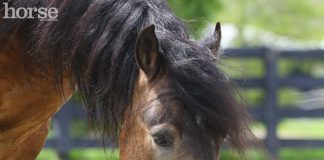Q: I have a horse that might have frostbite on his nose and ears. How can I tell if he has frostbite, and if he has it, what should I do about it?
When frostbite happens, it usually affects the tips of a horse’s ears, his lower legs and sometimes his tail.

Frostbite is very dangerous because it kills cells and tissue, and it can damage and deform affected areas, leaving ugly scars. You may not even know your horse has suffered frostbite until a few days later when the tips of his ears get stiff, turn dark and break off. Ouch!
If you suspect that your horse has frostbite, apply warm water to the affected areas with a towel. Check with your vet first, but you should probably give your horse some phenylbutazone (bute) or Banamine to control the pain he may feel as his extremities thaw out.
Prevent frostbite by giving your horse lots of hay to munch on in cold weather and making sure he is at a good weight going into winter. His field should have a run-in shelter, barn or trees to protect him from the wind.
This article originally appeared in the November/December 2014 issue of Young Rider magazine. Click here to subscribe!






